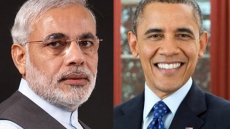India is projected to grow at 6.4 percent in 2015 with industrial production and other indicators turning around thanks to stronger business confidence since the parliamentary elections, according to the International Monetary Fund.
"India's growth outlook has improved since the last national election, helped by lower uncertainty and improved business confidence," the 188-nation watchdog of global economic health said in its October 2014 Update of Asia and Pacific Economic Outlook.
Despite a weaker-than-expected first half of the year, the outlook for the region remains solid, it said with GDP forecast to grow by 5.5 percent for the third consecutive year in 2014, rising slightly to 5.6 percent in 2015.
"In India, growth (based on GDP at factor cost) has gathered steam as industrial production and other high-frequency indicators have started to turn around on the back of stronger business confidence" since the last national elections, IMF said.
These developments have been accompanied by rising capital inflows as well as a revival in investment and industrial activity, it noted.
"India's GDP growth appears to have bottomed out," IMF said, forecasting its "rise to 5.6 percent in 2014, accelerating further to 6.4 percent in 2015, despite headwinds from ongoing fiscal consolidation and a tighter monetary stance".
But "India's high and persistent inflation remains a policy concern and is projected to decline only gradually, reaching 7.8 and 7.5 percent in fiscal years 2014 and 2015, respectively," IMF said.
Economic resilience to global financial risks has increased in the region, especially in India, where policy actions to reduce vulnerabilities have helped lower external and domestic imbalances, it said.
In India, for instance, international reserves have risen and the current account deficit has been slashed, contributing to a significant reduction in gross external financing needs, the regional update said.
Suggesting that reforms to maintain high and sustainable growth will also help lower near-term vulnerabilities, IMF advocated stronger investment and efficiency in India as important steps in this direction.
In the case of India, previous interest rate hikes and other policy measures are helping contain price pressures, and the full effect of past monetary tightening is yet to be felt, the update said.
"However, close vigilance is warranted, particularly in the event of large cost-push shocks or if there is evidence that inflation expectations become unmoored," it said.
"India also needs to further remove structural impediments to investment, including by further liberalizing its FDI regime and labour market regulations," IMF said.
"Energy sector policies are also needed in India to boost industrial activity," it said.
The update said the ongoing global recovery, while tepid, should support Asia's exports. "Meanwhile, favourable financial and labour market conditions, as well as broadly accommodative policies, will continue to underpin domestic demand" in the region.
"Policymakers in the region should capitalise on the outlook to gradually rebuild policy space and push ahead with structural reforms to deliver sustainable growth," the IMF suggested.






